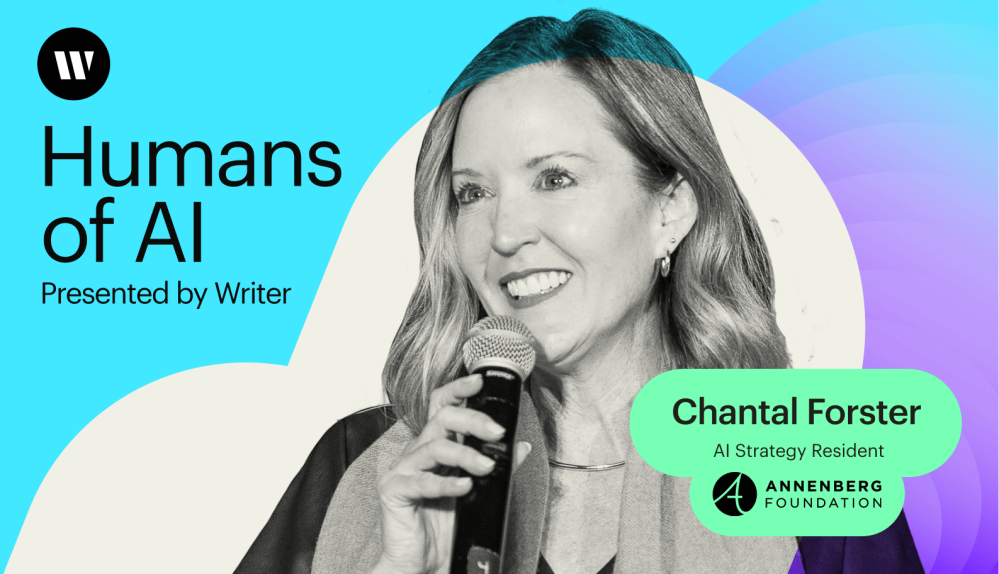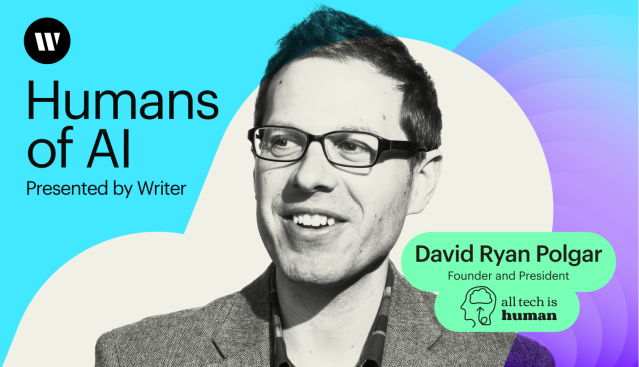Humans in the loop
– 8 min read
Navigating AI and philanthropy with Annenberg Foundation’s Chantal Forster

Imagine a world where AI isn’t just a tool for profit, but a catalyst that revolutionizes philanthropic processes. Where we design every algorithm not only to prioritize transparency, explainability, and inclusion, but also to support mission-driven work. Our latest guest on Humans of AI, Chantal Forster, believes this world is possible — and a lot closer than we might think.
Chantal is the AI strategy resident for the Annenberg Foundation and former executive director of the Technology Association of Grantmakers. With a background that spans across various sectors — including public service and nonprofit advisory — Chantal brings a unique perspective to the challenges and opportunities presented by AI in the philanthropic world.
Her vision for the future includes a more integrated approach to AI. A future that fosters connections between foundations and nonprofits, and makes sure that technology serves to enhance human relationships and mission-driven work.
- Chantal believes that the pace of the private sector is faster than that of the social sector, which can be challenging.
- The adoption of AI in philanthropy is still in its early stages, but there are discussions about using AI for internal operations and analyzing historical grant-making records.
- The philanthropic sector is largely tech-naive, she says, and there’s a need for more tech-savviness and a willingness to experiment with tech.
- Chantal thinks AI may change the grant application process, creating an improved, AI-enabled matchmaking process between funders and grantees.
Origin story of an AI innovator
Much like some of our previous HoAI guests, Chantal’s initial exposure to AI was in the form of automated vehicles. Her father, a computer scientist at Inland Steel, was working on automating steelmaking systems near the Great Lakes. Because of that she found herself immersed in the world of AI well before the turn of the 21st century.
“We didn’t call it AI then,” Chantal says, “but it was AI.” She was working as a tech writer for SPSS Predictive Analytics on their data mining platform. From that point on, her career has seamlessly blended technology with roles spanning both public and private sectors.
But, at the core of her professional journey, she has always focused keenly on the operational aspects of philanthropy. She says this stems from her upbringing in Chicago, where she witnessed firsthand the collective, inner workings of what it takes to pull off such a grand metropolis.
“I think because I grew up there, I’ve always been drawn to the intricacies of how to execute on something bigger than a single individual,” Chantal explains. “And I think that the fact that I’m now on the operation side of philanthropy is probably no accident as a result of that, because the inner workings of how you get to that social impact are very complicated. And we don’t often think about that in philanthropy.”
The intersection of philanthropy and AI
Chantal says that foundations typically consist of passionate, mission-driven individuals who may sometimes be unaware of or even slightly resistant to technology. She also points out that every touchpoint a nonprofit has with a grantmaker or foundation is mitigated by technology. This includes email, reporting, or online applications.
“The skeleton at this point of philanthropy is technology, whether we know it or not,” Chantal explains. “So sometimes it’s an uphill battle, working in philanthropy on a somewhat under-recognized component of mission enablement. But I happen to love it.”
Some foundations and organizations are currently wrestling with whether to hire for AI-related positions. Chantal suggests that rather than creating permanent AI positions, bringing in advisory experts on a short-term basis can be an effective strategy.
Which is exactly what the Annenberg Foundation did when they hired Chantal as their AI Strategy Resident. Her work there’s a more agile microcosm of the larger landscape of AI adoption and philanthropy.
Right now, she sees organizations exploring org-wide licenses for AI chatbots. Others are starting to use generative AI to discover new insights and connections from organizations’ historical grant-making records. But, she says very few are comfortable developing public-facing AI solutions.
“I think that’s something the sector should rise to the occasion of,” Chantal says. “There’s enough hallucinations and not enough source citations that philanthropy isn’t comfortable quite yet exposing any chatbots or custom AI applications externally to their grantees, nonprofits, partners, or the world.”
Responsible and transparent AI use
Chantal says responsible AI is one of the most important topics in philanthropy right now. Some foundations are pausing AI experimentation altogether because they don’t yet know how to begin wrestling with responsible and ethical AI use.
“I personally think that’s the wrong approach,” Chantal says. “Or if it’s an approach, I urge folks to have it be a temporary approach. We’re coalescing about what responsible AI means, right? It means transparency and usage. It means explainability. It means inclusion.”
At the Annenberg Foundation, Chantal emphasizes the significance of understanding people and culture in the context of AI before creating your own AI policies. They recently conducted an insightful exercise, inviting staff to adapt the six standard responsible AI principles to the foundation’s unique context.
“We discovered some really unexpected things,” Chantal explains. “For example, to staff, inclusion meant all staff get access to AI tools — not just the cool kids, not just the prominent department, not just the public-facing departments — but all of us get access to the same AI tools and all of us get access to the training we need to best use those tools.”
They also gave their staff an anonymous AI pulse check survey to gauge their thoughts on using AI. Chantal says their foundation staff didn’t feel the same sense of urgency or desire to use AI in almost every type of usage as their nonprofit partners.
“It’s hard for me to say this out loud because I love the sector I’m working in,” she admits. “But I think we have the privilege to be inefficient.”
A philanthropic foundation exists to give away enough dollars to maintain its nonprofit status.. Then, you have nonprofits having the exact opposite problem. They’re chasing dollars every day to fulfill their mission. Chantal urges philanthropy organizations to recognize that and ultimately realize that they may need to become more willing to experiment with and fund tech to help their nonprofits achieve their mission.
How AI can help foundations and nonprofits connect faster
Chantal isn’t worried about AI making foundations or non-profit relationships less human. She’d like to see AI improve the onerous parts of the process so that there’s more time for everyone to be human together and get to know each other.
She also wants to see some type of AI-enabled matchmaking between funders and grantees that could replace the traditional grant-making process.
“Not a 100% automated process, but like a suggested process — like a dating app. I’m not saying grant making is like dating, however,” Chantal clarifies. “There’s many points for human intervention and human decision-making and relationship-building throughout that process. I think we’ll see something like that in philanthropy and I’m excited for it.”
She admits there’s some complexity behind this idea because of the financial due diligence component. While there is — or will be — a market for an app like this, there’s also a data layer. And the data upon which grant nonprofits and foundations find each other and vet each other has to be some form of common data. Right now, there’s no clear answer to who owns that pool of data.
“I think you do need separate ownership and governance between the data layer and the app layer on top of it,” Chantal says. “But there’s some jostling and competitiveness in the sector right now about who will own that data layer.”
Chantal says that this type of competition is good in the social sector. When foundations have competitiveness, it can be healthy for innovation. Organizations need change management to create the conditions for them to thrive and embrace this natural spirit of curiosity.
When Chantal works with organizations about embracing emerging tech like AI, she says it’s about building a culture of resilience and change. Technology isn’t just about the process — it’s about the people it serves. By connecting technology and humanity, we make sure that every effort — no matter how small — contributes to a larger mission, getting the resources to those who need them the most, and making a tangible difference in people’s lives.
Want to hear more stories from the humans working at the crossroads of business and generative AI? Subscribe to Humans of AI wherever you listen to podcasts.


